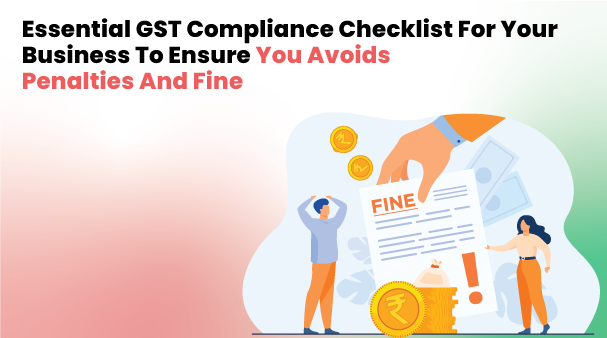Businesses in India must comply with the Goods and Services Tax (GST), rolled out from 1st July 2017 onwards. For every economic activity, GST is expected to impact the prices of commodities, investments, and business operations. Businesses that do not comply with GST are bound to pay heavy penalties.
This article will provide you with a complete GST compliance checklist that your business must abide by to ensure you avoid penalties and fines.
What is GST compliance?
The GST Council of India has imposed some rules on the way businesses maintain records, raise invoices, report purchases and sales, pay taxes, and file returns. GST compliance is all about adhering to and complying with the GST rules and regulations.
With the GST reform getting effective in India, businesses that are still not wholly GST compliant require careful compliance management. This article will help business organisations with knowledge on how to avail the opportunities offered by the new tax system.
Who is liable to register for the GST?
Business entities such as individuals, Hindu undivided families (HUF), corporations or government companies, LLPs formed under a foreign country’s law, cooperative society, local authorities and trusts engaged in trade and commerce are taxable under the GST Act. The list of entities liable for GST registration is given below:
- Goods suppliers between states: A business that supplies goods or services between states and comes under inter-state supply.
- Taxpayer: A business owner who supplies goods and services occasionally.
- Non-resident taxable person: A person who supplies goods or services in India without having any fixed business place or residence.
- Input service distributor
A goods or services supplier receives tax invoices for input services and issues a document for distributing the taxes imposed by the Union, state, integrated, or Union territory government on the services to a goods or services supplier.
What are the benefits of the GST?
GST is levied on the supply of goods and services from the manufacturer to the consumer. The benefits of GST are:
- Easier compliance: The taxpayer services such as returns, payments, and registrations, are available to the online taxpayers making easy compliance.
- Minimum tax cascading: A seamless credit of tax in the value chain ensures minimum tax cascading that reduces hidden business costs.
- Reduced goods and services cost: The entailing of major GST Central and State taxes, comprehensive input goods and services, and Central Sales Tax (CST) reduce the cost of goods and services, boosting Indian exports and reducing compliance costs.
- Revenue efficiency: GST will result in higher revenue efficiency by increasing tax compliance and, thereby, boosting the government’s collection.
How to fill the GST returns?
There are two ways to fill the GST returns, online and offline
- Online filing: One can file the GST returns online via the GST portal https://gst.gov.in with the help of their PAN number, monthly returns and verifying the inward and outward supplies.
- Offline filing: One can file the GST returns offline by visiting and downloading the offline tool. After that, one can fill in the GSTR-1 and GSTR-2 forms easily.
What are the Common GST Compliances?
GST law offers compliances to be done every month, quarter and half-year. Here are those GST compliances that need to be carried out:
- It is compulsory to do e-invoicing of your GST if your aggregate turnover is more than 50 Crores.
- An input tax credit reversal is needed for the credit of taxable and exempted supplies.
- Every GST registered person making zero-rated supplies needs to obtain or renew his Letter of Undertaking at the end of every financial year.
- A GST registered person with aggregate turnover exceeding Rs. 5 Crores must mention a 6-digit HSN code on the supply of goods or services on tax invoices.
- Any returns and reconciliation filed after the due date of annual returns are liable for a late fee of Rs.200 for every day, subject to a maximum of 0.5% turnover.
What records must be maintained under GST?
When GSTIN is applied, certain documents are to be submitted to the authorities, including a business’s address. The taxpayers must maintain the following records:
- The manufacture or goods production details.
- The inward and outward services or goods supply.
- Input tax credit.
- Output payable tax.
What are the common errors committed by many?
Common errors mentioned below, while filing GST returns, can result in losses and closure of the business:
- Wrong GST or invoice number: The GST portal has a matching mechanism where the data entered in GSTR 1 gets auto-populated in GSTR 2A. Quoting the wrong invoice or GSTIN will create a problem in filing the details.
- Data reconciliation: One must reconcile the GST returns data correctly. Taxpayers fill the GST returns data without a proper reconciliation resulting in a mismatch from the financials resulting in GST registration cancellation.
- Input tax credit reversal: The supply recipient must pay tax under the reverse charge mechanism. The supplier has to pay the tax, which is not refundable.
- Late return filing: Many taxpayers do not file the returns within the due date leading to a late fee, penalty and notice from GST authorities.
Is GST Applicable on Fine and Penalty?
GST is applicable for fines and penalties under Section 122 to 138 of the GST Act under the following circumstances.
Late Fee for GST return:
- A person who does not furnish the outward or inward supplies details, monthly or final return by the due date is liable to pay INR 100 for every day up to a maximum of INR 5,000.
- A person who does not furnish the annual return by the due date is liable to pay INR 100 every day up to a maximum of the person’s quarter percent turnover.
Interest for Late Payment of GST:
- A person who fails to pay the tax is liable for an interest payment of 18% from the first day from which the tax due is calculated.
- A person who makes an excess input tax credit claim is liable for an interest payment of 24%.
- A service recipient who does not pay the service amount within 180 days from the invoice date is liable for an interest payment of 18%
How do you avoid GST Penalty?
When a GST-registered business does not file its GST return before the due date, then it is liable to pay a late fee under Section 47 (2) GST Act, 2017. Below are the ways to avoid GST penalty:
- File all the pending returns immediately
- Businesses registered under GST but have failed to file returns since the registration date must apply for registration cancellation if there are no sales or purchases.
- Keep checking the tax filing status if a third party handles it.
How Wepsol GST Compliance Software helps you to file GST returns on time?
The Wepsol GST platform for filing returns is one of India’s best GST returns filing software. It offers to match 6,000 invoices at a moment where you can claim the input tax credit, get data security, and it is compatible with any ERP software. It offers experienced technical support, 99.99% uptime, and the module for invoice generation and customer data management in one place.
Get to know more about our Wepsol GST solution by filling out the form on our website.
Conclusion
GST is a major law, and understanding it in detail can be overwhelming for an ordinary man. Using the best GST Software for return filing can help you avoid penalties and pay GST returns on time.
In this article, we have tried to cover everything about GST compliance, the checklist to be followed while filing GST and the ways to avoid late penalties and fees while filing GST returns. Wepsol GST solution is the perfect software for filing your GST returns seamlessly. Using this software, you can easily file the GST returns without any hassle and do your billing on time.

